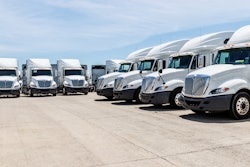
If sustainability should include a complete well-to-wheels outlook while attempting to sustain profitability, then the growing carbon neutral movement has a lot of growing to do—an awful lot.
During a FedEx webinar today the global parcel giant said it plans on becoming carbon neutral by 2040 chiefly through vehicle electrification. The term electrification is a broad one: it can refer to all-electric vehicles, fuel cell models or even hybrids.
So what percentage of FedEx’s fleet will include all-electric versus other carbon-cutting solutions? Who knows. Hydrogen station expansions certainly weren’t mentioned during the roughly ½-hour presentation. Charging stations were, however.
According to FedEx Chief Sustainability Officer Mitch Jackson, the company has stepped up its EV presence in California along with its charging infrastructure which has climbed to 42 stations that offer a total of 500 charging outlets.
Forty-two stations…that’s just shy of the total number of hydrogen stations across the U.S. according to the U.S. Department of Energy.
To be clear, FedEx has a history of using fuel cell technology along with a mix of other alternative fuels. They’ve reduced their CO2 output by 40% over a roughly 12-year period while packing volume soared 99%. That’s pretty amazing.
But it was painfully obvious during the webinar that hydrogen fuel cells (another zero-emissions path) and those “other solutions,” as they were called (like natural gas, biodiesel and renewable diesel), had been relegated to the back of the bus.
Similar to President Joe Biden’s plan on electrifying the massive federal fleet (65% of which are comprised of trucks), there was no mention of big plans for expanding hydrogen infrastructure, biodiesel, renewable diesel or renewable natural gas. These fuels offer a low carbon alternative particularly when coupled with near-zero emissions engines. Even better, renewable natural gas actually has a carbon negative score that typically beats electric since—an inconvenient truth here—EVs are frequently charged from carbon-spewing power plants.
That brings us to the critical well-to-wheels perspective where if a fleet is aiming hard for carbon neutrality they will consider the power sources for their EVs. Not only that, but they will address EV battery recycling, repurposing and disposal. Once an EV battery reaches roughly 80% degradation or the point at which it’s no longer suitable for powertrain use, it can be repurposed and used as a power source to charge other EVs or as back-up power when the lights go out. Recycling is another important topic especially considering the highly toxic elements used in EV batteries. The process is not entirely efficient at this point and renders a lot of toxic sludge. So what do you do with that? Store it in a warehouse somewhere? I seriously doubt that any fleet wants to be part of a fractured and vulnerable cycle that does not readily address battery recycling and ultimately disposal.
And—perish the thought—what happens if the grid goes down as we saw on such a large and tragic level in Texas? How do you move your EVs then? Solar-charged repurposed EV batteries will only supply so much juice. Do fleets then turn to diesel generators as President Joe Biden did when going to the aid of power-deprived Texans? How much will that cost and how many generators will a fleet need on standby?
FedEx isn’t the only one not seemingly ready to take on these topics. Ford, GM and Rivian told me that they weren’t ready to comment on the EV battery lifecycle. Amazon, which uses Rivian’s electric vans, didn’t offer up any clear-cut responses. At one point, Motiv seemed ready to talk and then demurred. BYD, Daimler and Workhorse failed to respond at all. Only one manufacturer to date has agreed to an interview on the topic. I was pretty shocked by that point. More on that later. It’s amazing how many billions of dollars are getting poured into EV development in all vehicle classes yet the topics of battery lifecycle management and power back-up solutions just seem to rock the boat too much. Too bad.
FedEx’s new partnership with Yale University (the company pledged $100 million to help establish the Yale Center for Natural Carbon Capture) may help address some of these vital concerns but as it stands now, the carbon neutral movement—particularly in the commercial sector—is a stumbling and concerning toddler, albeit it with potential, that has a long way to go to maturity.
Simply put, any presentation on sustainability concerning carbon neutrality needs to be inclusive and definitive in its well-to-wheels carbon outlook. If carbon is going to be counted, then consider all the chips on the table.
And while any sensible person wants to sustain the environment, sustaining profitability is also important. There’s no question that EVs do offer a very attractive TCO benefit (40% lower than conventional Ford reported on its yet-to-be released electric Transit), but they’re not always going to have the power fleets need to get the job done.
Case in point, NFI Industries, a leading third-party logistics provider, told me that their electric Freightliner eCascadias can only make two round trips to bustling Southern California ports whereas their diesel counterparts can make three. The reason? The trucks simply do not have the range. P&D vehicles, particularly smaller class vans and trucks, can prove to be a better fit in this regard so long as range is respected.
Range issues will hopefully change as new battery technologies emerge (QuantumScape and Toyota have both reported promising results with solid-state R&D), but as it stands now when I think of carbon neutrality goals I can’t help but think of an old Orson Welles TV ad in which he locks eyes with the camera and opines in that hypnotic baritone, “We will sell no wine before its time.”
Really, the worst a fledgling carbon neutral consortium can do at this point is offer a biased portrayal of sustainability that is not entirely developed in its outlook.










